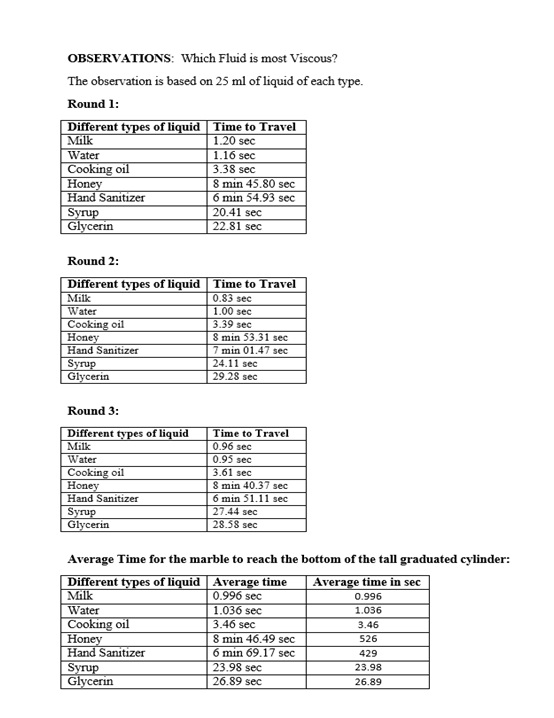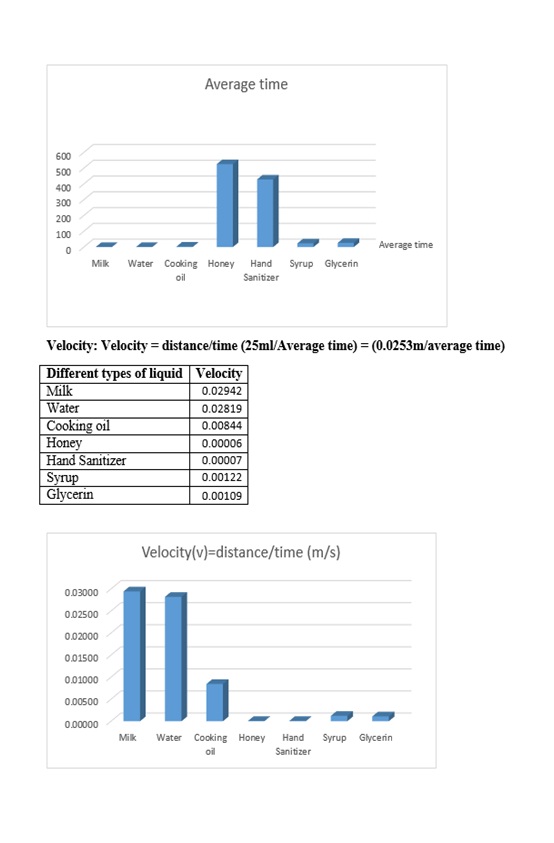





Published on Feb 13, 2025
The objective: To determine the differing viscosities of selected liquids by passing a marble through the substances and measuring the resultant velocities.
To find out whether milk, glycerin, honey, cooking oil, hand sanitizer, syrup, and water has the most viscosity.
My hypothesis is that honey has the most viscosity.
• Tall Graduated Cylinder
• Marble
• Stopwatch
• Notebook and Pen
• Cooking oil
• Syrup
• Honey
• Glycerin
• Honey
• Hand Sanitizer
• Milk
1. Fill the graduated cylinder with one of the sample liquids. Leave a couple of centimeters at the top so it does not overflow. Be sure to fill the cylinder up to the same amount of liquid each time.
2. Hold the marble at the opening of the graduated cylinder in one hand and the stop watch in the other hand.
3. Simultaneously drop the marble and start the stopwatch.
4. Stop the timer when the marble passes through the liquid and touches the bottom of the cylinder.
5. Record the name of the liquid you tested, the original height of the liquid, and how long it took for the marble to fall in seconds.
6. Repeat the experiment 2 more times for each liquid so there is enough data to take an average. Calculate the average time.
Average time = (time 1 + time 2 + time 3) / 3
7. Calculate the average velocity of the marble through the liquid. The distance is the height of the liquid, and the time will be the average time calculated in Step 6.
Velocity = distance / time
8. Repeat the experiment testing other liquids.


My hypothesis was correct! Out of all the liquids I tested (honey, water, milk, cooking oil, glycerin, hand sanitizer, and syrup), honey is the most viscous and milk is the least. During my observations, I found out that honey and hand sanitizer were very close compared to other liquids but at the end, honey beat hand sanitizer. I have also found that there is inverse relationship between the velocity of an object passing through a liquid and the viscosity of that liquid. Engineers, doctors, volcanologists, and scientists all use viscosity in practical life.
Conley, Ken. "Episode 72: Underwater Car and Which Fluid is the most Viscous." Annotated Mythbusters. Ken Conley, 24 Jan. 2007. Web. 15 Apr. 2014. <http://kwc.org/mythbusters/2007/01/episode_72_underwater_car_and.html>.
Historical Society of Pomona Society. "Folding Paper in Half Twelve Times."Folding Paper in Half Twelve Times. Historical Society of Pomona Society, n.d. Web. 12 Apr. 2014. <http://pomonahistorical.org/12times.htm>.
Stier, Caitlin. "Students Break Record by Folding Toilet Paper 13 times." New Scientist TV. New Scientist, 11 Jan. 2012. Web. 12 Apr. 2014. <http://www.newscientist.com/blogs/nstv/2012/01/paper-folding-limits-pushed.html>.
Weisstein, Eric W. "Folding." From MathWorld-A Wolfram Web Resource, n.d. Web. 18 Apr.2014 <http://mathworld.wolfram.com/Folding.html>